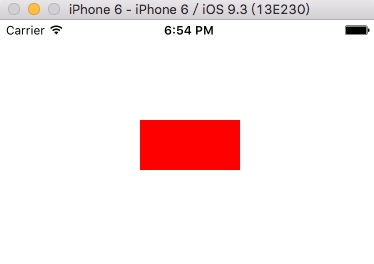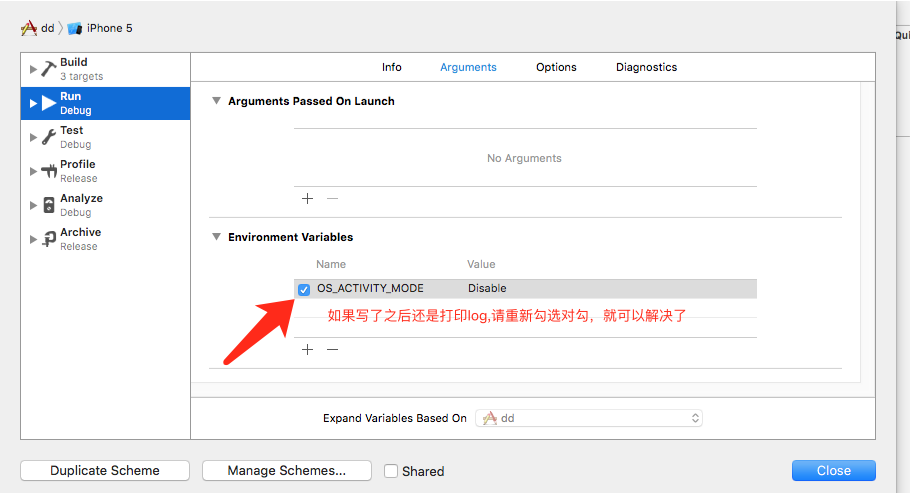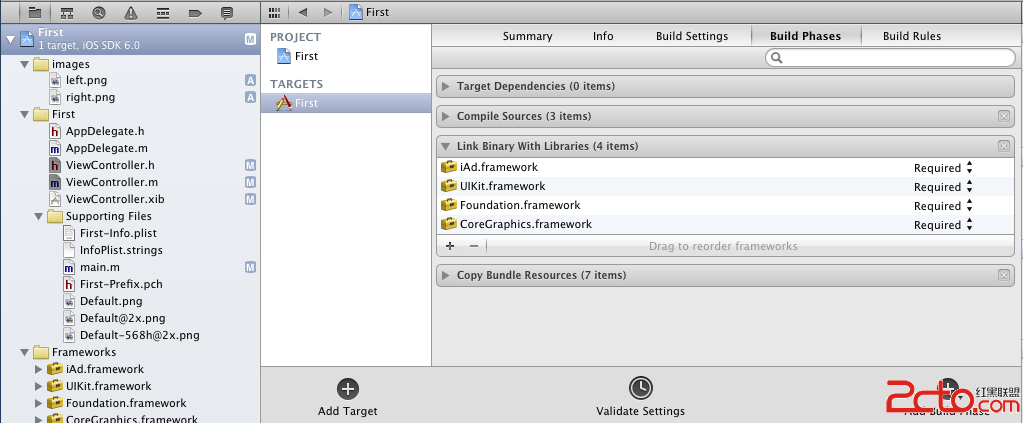詳解iOS中按鈕點擊事件處理方式
寫在前面
在iOS開發中,時常會用到按鈕,通過按鈕的點擊來完成界面的跳轉等功能。按鈕事件的實現方式有多種,其中較為常用的是目標-動作對模式。但這種方式使得view與controller之間的耦合程度較高,不推薦使用;
另一種方式是代理方式,按鈕的事件在view中綁定,controller作為view的代理實現代理方法。
目標-動作對實現方式
具體來說,假設我們有一個包含一個Button的veiw,view將Button放在頭文件中,以便外部訪問。然後controller將view作為自己的view,在viewcontroller中實現按鈕的點擊事件。文字描述起來好像不夠直觀,直接上代碼
1、MyView.h
包含一個可被外部訪問的按鈕的view
@interface MyView : UIView @property (strong, nonatomic) UIButton *myBtn; @end
2、MyView.m
#import "MyView.h"
@implementation MyView
//view的初始化方法
- (id)initWithFrame:(CGRect)frame
{
self = [super initWithFrame:frame];
if (self)
{ //初始化按鈕
_myBtn = [[UIButton alloc] initWithFrame:CGRectMake(140, 100, 100, 50)];
_myBtn.backgroundColor = [UIColor redColor];
//將按鈕添加到自身
[self addSubview:_myBtn];
}
return self;
}
@end
3、MyViewController.h
#import <UIKit/UIKit.h> @interface MyViewController : UIViewController @end
4、MyViewController.m
添加MyView作為自身view
#import "MyViewController.h"
#import "MyView.h"
@interface MyViewController ()
@property (strong, nonatomic) MyView *myview;
@end
@implementation MyViewController
- (void)loadView
{
MyView *myView = [[MyView alloc] initWithFrame: [[UIScreen mainScreen] bounds] ];
self.view = myView;
self.myview = myView;
//在controller中設置按鈕的目標-動作,其中目標是self,也就是控制器自身,動作是用目標提供的BtnClick:方法,
[self.myview.myBtn addTarget:self
action:@selector(BtnClick:)
forControlEvents:UIControlEventTouchUpInside];
}
//MyView中的按鈕的事件
- (void)BtnClick:(UIButton *)btn
{
NSLog(@"Method in controller.");
NSLog(@"Button clicked.");
}
5、 AppDelegate.m
#import "AppDelegate.h"
#import "MyViewController.h"
@interface AppDelegate ()
@end
@implementation AppDelegate
- (BOOL)application:(UIApplication *)application didFinishLaunchingWithOptions:(NSDictionary *)launchOptions {
self.window = [ [UIWindow alloc] initWithFrame: [[UIScreen mainScreen] bounds ] ];
MyViewController *myVC = [[MyViewController alloc] init];
self.window.rootViewController = myVC;
self.window.backgroundColor = [UIColor whiteColor];
[self.window makeKeyAndVisible];
return YES;
}
6、運行結果
界面:

輸出:

7、小結
這種將view中的屬性暴露在頭文件中的方式在一定程度上破壞了封裝性。因為一旦將屬性暴露在頭文件中,外部任何包含該view的類可能在不知情的情況下修改了屬性,這不符合代碼高內聚、低耦合的開發要求,因此不推薦這種編寫按鈕事件的方式。
代理監聽按鈕事件
使用代理監聽按鈕事件的思路是:不暴露view中的按鈕,而是為按鈕創建一個代理,在view頭文件中聲明一個代理,然後讓controller成為view的代理,並實現代理方法,在view中回調controller中的回調方法,從而實現按鈕事件。具體代碼如下:
1、MyView.h -- 不再將按鈕暴露在頭文件中
在頭文件中聲明一個協議,協議也可以寫在單獨的文件中,然後通過import導入。
#import <UIKit/UIKit.h> //自定義的按鈕協議,該協議實現了<NSObject>協議,協議的名稱自定,不過不要和Apple的協議重名 @protocol myBtnDelegate <NSObject> //協議中的方法,遵循該協議的類提供其具體的實現,協議有@optional和@required兩個修飾符,默認情況下是@required - (void) BtnClick:(UIButton *)btn; @end //MyView的接口 @interface MyView : UIView //聲明一個屬性,這個屬性用於指定誰來成為本類的代理,由於不能確定什麼類型的對象會成為本類的代理,因此聲明為id類型 @property (weak, nonatomic) id<myBtnDelegate> delegate; @end
2、MyView.m
按鈕被封裝在.m文件中,同時在.m文件中提供一個本地方法,在本地方法中調用代理的代理方法
#import "MyView.h"
@interface MyView ()
//聲明在.m中的按鈕對外部不可見
@property (strong, nonatomic) UIButton *myBtn;
@end
@implementation MyView
//初始化
- (id)initWithFrame:(CGRect)frame
{
self = [super initWithFrame:frame];
if (self)
{
_myBtn = [[UIButton alloc] initWithFrame:CGRectMake(140, 100, 100, 50)];
_myBtn.backgroundColor = [UIColor redColor];
//為按鈕設置目標-動作,其中目標是self即包含該按鈕的view自身,動作是有目標(view)提供的myBtnClick:方法
[_myBtn addTarget:self
action:@selector(myBtnClick:) forControlEvents:UIControlEventTouchUpInside];
[self addSubview:_myBtn];
}
return self;
}
//view中按鈕的事件
- (void)myBtnClick:(UIButton *)btn
{
NSLog(@"Method in view");
//在回調代理方法時,首先判斷自身的代理是否實現了代理方法,否則會導致崩潰
//如果自身代理實現了代理方法,在該方法中回調代理實現的具體的代理方法
if ( [self.delegate respondsToSelector:@selector(BtnClick:)] )
{
[self.delegate BtnClick: btn];
}
else
{
NSLog(@"BtnClick: haven't found in delegate.");
}
}
@end
3、MyViewController.h
同上(目標-動作對實現方式)
4、MyViewController.m
#import "MyViewController.h"
#import "MyView.h"
//聲明該controller遵循 <myBtnDelegate>協議,因此需要實現協議中的方法
@interface MyViewController () <myBtnDelegate>
@end
@implementation MyViewController
- (void)loadView
{ //創建MyView類型的myView
MyView *myView = [[MyView alloc] initWithFrame: [[UIScreen mainScreen] bounds] ];
//將myView的代理設置為self,即當前controller自身
myView.delegate = self;
//將controller的view指向myView
self.view = myView;
}
//該方法是代理中的方法,在controller中決定點擊myBtn按鈕後具體要做的事情,但controller並不能直接獲取到myBtn
- (void)BtnClick:(UIButton *)btn
{
NSLog(@"Method in controller.");
NSLog(@"Button clicked.");
}
5、AppDelegate
同上(目標-動作對實現方式)
6、運行結果
界面同上
日志:

7、小結
從日志可以看出,使controller成為view的代理,實現按鈕的代理方法,與按鈕相關的方法的執行順序為:view中按鈕的動作方法->controller提供的按鈕代理方法。
事實上,在代理模式中,有三個角色存在:
- 協議:一般是方法列表,規定了代理雙方行為,在本例中 就是協議;
- 代理:遵循一定的協議的類,需要實現協議中的必須方法,完成委托方的功能,本例中MyViewController就是代理;
- 委托:擁有自己的代理,指定代理去完成功能,本例中的MyView就是委托。
代理模式用大白話說就是:委托方讓代理方代替自己執行一定的動作。
總結
iOS中,類不能多繼承,但協議是可以多繼承的。協議並不提供具體實現。協議一般是一系列方法的集合,(也可以有屬性,但這不是協議的主要使用場景),這有點像Java中的接口,繼承接口的類負責提供接口中方法的具體實現。
代理模式在iOS開發中使用的地方有很多,代理模式能夠實現view和controller之間的解耦。拿本文中的例子來說,controller雖然可以操作view中按鈕點擊後的操作,但由於按鈕是作為view的私有屬性聲明在view的實現文件中的,因此controller並不知道view中有按鈕這個屬性的存在,因此無法從view外部去更改按鈕的各屬性,這就是view和controller之間解耦的體現。此外,由於按鈕事件是在view中綁定的,而不是在controller中綁定的,因此使用該view的類只需要實現相應的代理方法就可以定制按鈕點擊後的事件了,這也更加方便了view的復用,體現了view與controller解耦合的優勢。
以上就是本文的全部內容,希望對大家的學習有所幫助,也希望大家多多支持本站。




